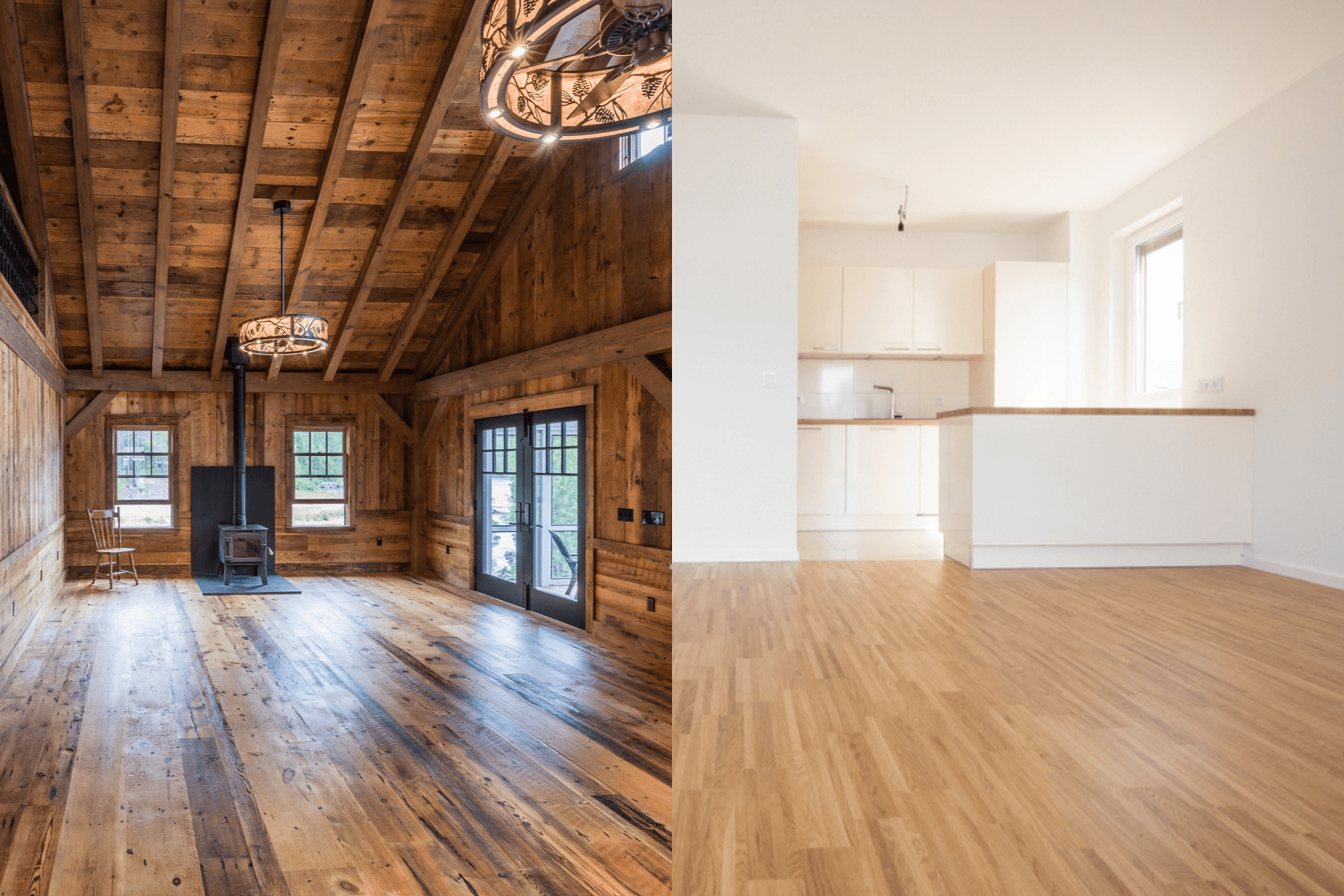Nothing shines quite like a wood floor. The rich brown. The smooth surface. The beautiful grains and knots. But with a great floor comes great responsibility (and sometimes, a higher price). Today, we’re going to compare wood flooring costs for reclaimed wood vs new wood so you can understand exactly what you’re paying for.
Wood Flooring Costs: The Basics
If you know absolutely nothing about wood flooring costs, you’ve come to the right place. In general, there are two types of wood flooring: new wood and reclaimed wood.
New Wood
New wood is wood you buy from a big-box store like Home Depot or Lowes. The price of a hardwood floor depends on a few factors. First is the type of wood you choose (including its species, thickness, and grade). Second is the size of your space. On average, the cost of new wood flooring is about $4 to $6 per square foot for the materials and installation.
You can choose from solid wood or engineered wood. Solid wood is a single piece of lumber that can give you that classic wood flooring look. You can refinish it multiple times, making it ideal for high-traffic areas. Engineered wood is made from layers with a plywood core and thin veneer of hardwood on top. It resists warping and moisture, but you can only refinish it once or twice.
When researching the cost of new wood flooring, solid wood is typically more expensive than engineered.
Reclaimed Wood
Next, we have reclaimed wood. Reclaimed wood is old-growth wood that has been repurposed from a run-down barn or warehouse. We upcycle and clean it before it’s finally ready to install in your home.
A lot of people wonder: is reclaimed wood cheaper? It’s not like buying clothes in a thrift store, where you can expect to pay half the price or less. Reclaimed wood goes through a long process to get it ready for your home, from demolition to kiln drying and beyond.
So is reclaimed wood cheaper than new lumber? Not always.
If you’re using a common wood type, then it may be less expensive. But if you have a rare wood type, then you’ll pay more per square foot. Once the wood is cleaned, it can start around $4 a board foot, but the average planking is about $6-$8. For flooring, it may be a little more.
But what, exactly, makes reclaimed wood worth the price?
What Makes Reclaimed Wood Unique
We’ve already answered the question, “Is reclaimed wood cheaper?” But let’s break down why the price is the way it is and some of the benefits of reclaimed wood.
Demolition
As we mentioned above, reclaimed wood has to go through an extensive process to get it ready for your home. We find most of our wood from old barns, warehouses, factories, fences, and mushroom farms.
We personally source the wood from surrounding states like Pennsylvania, New Jersey, New York, Delaware, and Ohio. The first step in reclaiming is to tear down the building and harvest the wood. This can take anywhere from one to three weeks, depending on the size of the structure.
Our experts will visit your site to assess the condition of the wood, the species, and its value. Then our crew will remove your barn or other structure and haul away any leftover pieces that aren’t useful.
See a demolition in action so you can understand why reclaimed wood flooring cost is more expensive.
Cleaning
Demolition is just the beginning. Now we have to clean your reclaimed wood.
We start by removing any nails and other metal from the wood. Denailing is a time-consuming process, especially because not all nails are visible on the surface. Our expert craftsmen can spend hours extracting hazards from a single plank. We have someone working on this at all times, and we can spend days in a row removing nails.
Now that the wood is metal-free, we can begin clearing off the dirt. Typically, we power wash it or run it through a wire brush machine to get rid of any debris, whitewash, lead paint, and more. The finished result is clean, smooth lumber with lots of character.
Next, salvaged wood is treated. We kiln dry it to kill bugs and remove all moisture. We also offer an additional Bora-Care® treatment to help it stay termite-free.
Finally, our wood goes through extensive sorting, so that homeowners like you can find exactly what you’re looking for!
Aging Process
Another feature of reclaimed wood that makes it more expensive is the aging process. The wood we source is hundreds of years old. Time enhances the beautiful characteristics of wood that we love so much, highlighting the hues, knots, and rings. This charm has to be worth something. After all, you can’t buy history off a shelf.
For example, we tore down a 19th-century barn in York County, PA. It was built in the early 1800s, and for years it was used to store wagons, carriages, hay, and horses. It was passed down from family to family over the years, and eventually the wood weathered to gray.
With our help, this wood was able to carry on a new legacy in future building projects—as mantels, flooring, decorative beams, and even ceiling panels in a summer home in Vermont. Each piece has a story to tell, and there’s nothing quite like it.
Wood Species
Another piece of the wood flooring cost puzzle is the species. At big-box stores, you can only find common varieties of wood, like red oak, white oak, and hickory.
But when you shop reclaimed wood, you have access to rare species like American chestnut. Due to a blight centuries ago, American chestnut trees are suffering and the wood is no longer readily available. You can’t just go to a lumber mill and buy it. The same goes for original hand-hewn wood. The only way to use it in your project is to salvage it from an older structure.
We also have access to old-growth wood. Reclaimed old-growth pine came from trees that were hundreds of years old. This makes the wood extremely dense with beautiful, compact growth rings—almost 30 per inch! You can’t get this tight grain in new pine, which typically has only 3-5 rings per inch.
Our access to rare wood types with unique grains makes it a pricier option because you’re getting something special.
Unique Characteristics
Another factor that impacts the price is character. Reclaimed wood comes with unique features that should be celebrated, not avoided.
These visual characteristics of wood include checks, worm holes, nail holes, knots, unusual grain patterns, mineral deposits, and uneven edges. Reclaimed lumber isn’t perfect, and that’s what we love about it! Each plank is completely unique, creating a wood floor that you can’t find anywhere else. A floor with character. A floor with history. A floor that is totally, completely you.
Reclaimed wood is also sustainable. It prevents lumber from ending up in landfills, and it reduces deforestation, shrinks your waste and carbon emissions, and limits chemical pollution.
Lastly, this wood is stronger. Since it’s from old-growth trees, it is harder and denser than new lumber. This ensures whatever you’re building will be strong for years to come. So while you’re paying more, you’re also getting more in return.
Reclaimed wood (left) and new wood (right)
Our Expertise
Lastly, you’re paying for our expertise. Our team comes from a long line of expert craftsmen who have honed the unique skills of woodworking and metal forging. Our products are works of art, and the reclaimed wood flooring cost reflects that. We believe in quality items at fair prices.
We also take time to source only the best materials for you to create statement pieces in your home. We reclaim and clean the wood ourselves to ensure it’s up to our standard. Every project we work on is unique and requires a different skill and design style to complete it.
New Floors, New You
Now that you understand the benefits of reclaimed wood, hopefully the price makes more sense. The cost of new wood flooring may be cheaper, but you’re losing out on the character, history, strength, and expertise that we provide.
Transform your home today with reclaimed wood flooring that sets your space apart. We offer white oak, red oak, chestnut, mixed hardwoods, white and yellow pine, and heart pine. Whatever your vision, our team is here to help!


